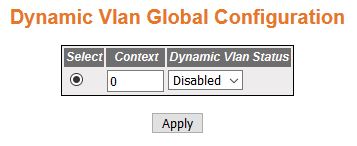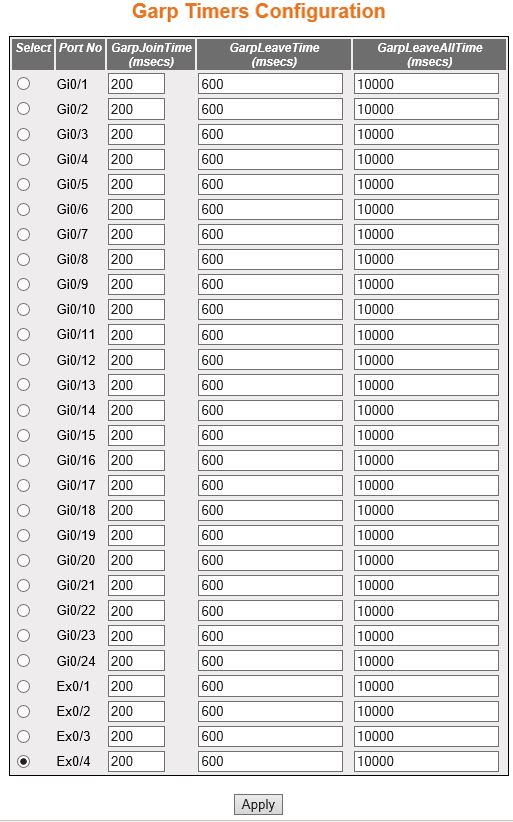This section describes the Dynamic VLAN or GVRP features
on the switch.
Dynamic VLAN feature (GVRP) allows GVRP aware devices to dynamically
establish and update the information about the existence of the VLANs in the topology. It uses
the services of GARP to propagate VLAN registration information to
other VLAN aware bridges in the
LAN. GVRP learnt dynamic VLAN memberships are stored in VLAN current database.
The dynamic VLAN feature cannot
run in the C-VLAN component of a provider edge bridge.
To access Dynamic VLAN screens, go to .
Dynamic VLAN Global Configuration
By
default, the tab Dynamic VLAN displays the Dynamic
VLAN Global Configuration Screen.
Figure 1. Dynamic
VLAN Global Configuration

| Screen Objective |
This screen allows the user to globally enable/disable
dynamic VLAN feature (GVRP) for the virtual contexts
available in the switch. To shut down GARP for the
specific context, the Dynamic VLAN feature
should be disabled |
| Navigation |
|
| Fields |
- Select—click
to select the context for which the configuration needs to be done.
- Context—displays the virtual context
ID that uniquely represents a virtual switch created in the physical
switch. This value ranges from 0 to 65535. The default value is
0.
|
| Fields |
- Dynamic VLAN Status—select
the administrative status requested by management for GVRP. The default option is Enabled
for the default context ID (0) and Disabled for other context IDs.
The list contains:
- Enabled—enables GVRP on
the switch, on all ports for which GVRP is not
specifically disabled in the Dynamic VLAN Port
Configuration screen.
- Disabled—disables GVRP on
all ports of the switch and transparently forwards all GVRP packets.
Note: The administrative
status affects all GVRP applicant
and registrar state machine. All GVRP state
machines on all ports are idle when status is changed from Disabled
to Enabled.
|
| Buttons |
- Apply—modifies
attributes and saves the changes.
|
Dynamic VLAN Port Configuration
Figure 2. Dynamic
VLAN Port Configuration

| Screen Objective |
This screen allows the user to configure the
dynamic VLAN feature related
parameters for every physical port available in the switch. |
| Navigation |
|
| Fields |
- Select—click
to select the context for which the configuration needs to be done.
- Context—displays the virtual context
ID that uniquely represents a virtual switch created in the physical
switch. This value ranges from 0 to 65535. The default value is
0.
- Dynamic VLAN Status—select the state
of GVRP operation in the port.
This state affects all GVRP applicant and registrar state machines
in the port. All GVRP state machines
in the port are reset once the state is changed from Disabled to
Enabled. The default option is Enabled on all physical ports. The
list contains:
- Enabled—enables GVRP in
the port, only if Dynamic VLAN Status
is globally enabled. Otherwise GVRP is
not enabled in the port. Once the Dynamic VLAN Status
is globally disabled, GVRP enabled
in the port is also disabled.
- Disabled—disables GVRP in
the port, even if the dynamic VLAN feature (Dynamic VLAN Status) is globally enabled.
Silently discards any received GVRP packets
and does not propagate GVRP registrations from
other ports.
- Restricted VLAN Registration—displays
the virtual context ID that uniquely represents a virtual switch
created in the physical switch. This value ranges from 0 to 65535.
The default value is 0.
- Enabled—enables restricted VLAN registration. That is, the
creation or modification of a dynamic VLAN entry
is permitted only for VLAN for
which static VLAN registration
entries exist.
- Disabled—disables restricted VLAN registration.
That is, the creation or modification of a dynamic VLAN entry is permitted for all VLANs.
|
| Buttons |
- Apply—modifies
attributes and saves the changes.
|
GARP Timers Configuration
Figure 3. GARP Timers Configuration

| Screen Objective |
This screen allows the user the user to configure
the timer used in GARP on physical ports
available in the switch. GARP uses
these timer values to control transmission of GARP PDUs used in synchronizing
the attribute information between the switches and in registering
and de-registering of attribute values. |
| Navigation |
|
| Fields |
- Select—click
to select the port for which the configuration needs to be done.
- Port No—displays the port, which is a
combination of interface type and interface ID. The interface ID
is a combination of slot number and the port number (slot number/port
number).
- GarpJoinTime (msecs)—enter the time duration
till which a GARP participant must
wait for its join message to be acknowledged before re-sending the
join message. The join message is re-transmitted only once if the
initial message is not acknowledged. This timer is started when
the initial join message is sent. The join message is sent by a GARP participant to another GARP participant for registering:
- Its attributes with another participant
- Its manually configured attributes
- Attributes received from a third GARP participant
This
value is represented in milliseconds. The default value is 200.
The value can only be set as multiple of tens (e.g., 210, 220, 230
and so on).This value should satisfy the condition: GarpJoinTime
> 0 and (2*GarpJoinTime) < GarpLeaveTime
- GarpLeaveTime
(msecs)—enter the time duration till which a GARP participant must wait for
any join message before removing attribute details (that is, waiting time
for a registrar to move from empty state (MT) to leave state (LV)).
This timer is started when a leave message is sent to de-register
the attribute details.The leave messages are sent from one GARP participant to another one
as follows:
- Its attributes should be de-registered
- Its attributes are manually de-registered
- leave messages are received from a third GARP participant
- GarpLeaveAllTime (msecs)—enter the time
period during which the details of the registered attributes are
maintained. The attribute details should be re-registered after
this time interval. A leaveall message is sent from a GARP participant to other GARP
participants, after this time interval. This timer is started once
a GARP participant started or
re-registration is done. The leaveall messages are sent from a GARP participant to other participants
for:
- De-registering all registered attributes
- Re-registering all attributes with each of the participants.
This value is represented in milliseconds. The default value is
10000. You can set the value as multiple of tens (that is, as 10010,
10020, and so on).
- The leave all time should be greater than 0 and greater than
GarpLeaveTim
|
| Buttons |
- Apply—modifies
attributes and saves the changes.
|
GARP Clear Statistics
Figure 4. GARP Clear Statistics

| Screen Objective |
This screen allows the user to clear the GARP statistics for a specified
interface or all interfaces |
| Navigation |
|
| Fields |
- Clear garp Statistic—click
to select which GARP statistics
have to be cleared.
- All—clears the GARP statistics
for all port information in the switch
- Interface—clears the GARP statistics
for the specified interface in the switch
- Interface—select the interface which
clears the GARP counters on the
switch.
Note: This field is greyed out when the Clear GARP Statistics option is All.
|
| Buttons |
- Apply—modifies
attributes and saves the changes.
|